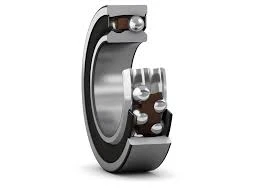
Nov . 15, 2024 14:08 Back to list
select a single row deep groove ball bearing
Selecting a Single Row Deep Groove Ball Bearing A Comprehensive Guide
When it comes to mechanical engineering and the design of rotating machinery, bearings play a crucial role in ensuring smooth operation and reducing friction. One of the most commonly used types of bearings is the single row deep groove ball bearing. Recognized for its versatility and efficiency, this type of bearing finds applications in various industries, from automotive to aerospace. In this article, we will explore what single row deep groove ball bearings are, their key features, benefits, and guidelines for selecting the right one for your needs.
What Are Single Row Deep Groove Ball Bearings?
Single row deep groove ball bearings are a type of rolling element bearing that consists of an inner ring, an outer ring, a cage (or separator), and a set of balls. The raceway grooves in both the inner and outer rings are deep, allowing for higher load capacity and accommodating both radial and axial loads. Their simple design and ease of manufacturing have contributed to their widespread use in numerous applications.
Key Features
1. Versatile Load Capacity Single row deep groove ball bearings can support radial and moderate axial loads, making them suitable for a variety of applications where these load types are present.
2. Durability Made from high-quality materials, such as chrome steel or stainless steel, they offer excellent wear resistance and longevity under various operating conditions.
3. Size Variability These bearings come in a wide range of sizes, providing options for different machinery and equipment specifications.
4. Low Friction The precision engineering of the ball and raceways results in reduced friction, which enhances efficiency and decreases the overall energy consumption of the machinery in which they are used.
5. Relatively Low Cost Compared to other types of bearings, single row deep groove ball bearings are generally more affordable, making them an economical choice for many applications.
Benefits of Using Single Row Deep Groove Ball Bearings
1. Efficiency Their low friction and excellent load distribution capabilities lead to improved overall system efficiency. This is particularly beneficial in high-speed applications.
2. Easy Installation The design of these bearings allows for straightforward installation and removal, which simplifies maintenance and reduces downtime.
select a single row deep groove ball bearing

3. Noise Reduction The smooth operation of single row deep groove ball bearings contributes to lower noise levels in machinery, which can be a significant advantage in many environments.
4. Wide Applicability Industries that benefit from these bearings include automotive, industrial machinery, electric motors, and agricultural equipment, among many others.
Guidelines for Selecting the Right Bearing
When selecting a single row deep groove ball bearing, several factors should be considered to ensure optimal performance
1. Load Requirements Identify the types of loads (radial, axial) that the bearing will encounter. Ensure the selected bearing can accommodate those loads comfortably.
2. Speed Ratings Check the bearing's maximum speed ratings. Different designs and materials will have varying speed capabilities.
3. Operating Environment Consider environmental factors such as temperature, humidity, and exposure to contaminants. Bearings may require special seals or lubrication to function effectively in harsh conditions.
4. Size Specifications Measure the available space and determine the required dimensions. Ensure compatibility with the supporting shaft and housing.
5. Material Considerations Depending on the application, you may need bearings made from corrosion-resistant materials, such as stainless steel.
6. Lubrication Decide on the lubrication method. Bearings can be pre-lubricated or require periodic lubrication. The correct lubricant will enhance lifespan and reduce maintenance needs.
7. Brand and Quality Opt for reputable manufacturers known for producing high-quality bearings. Investing in a well-regarded brand can prevent premature failures and reduce long-term costs.
Conclusion
Single row deep groove ball bearings are essential components in a multitude of mechanical systems. Understanding their features, benefits, and the parameters for selection can lead to more efficient and reliable machinery. By carefully considering load requirements, operating conditions, and material specifications, engineers and designers can ensure they choose the right bearing for their specific applications, ultimately enhancing performance and longevity in their systems.
Latest news
-
Premium Deep Groove Ball Bearings | High Speed & Reliability
NewsAug.29,2025
-
Durable Scaffolding Clamps - Secure & Reliable Tube Connectors
NewsAug.28,2025
-
Common Failures in Thrust Ball Bearings and Solutions
NewsAug.22,2025
-
How Tapered Roller Bearings Can Take Shock Loads
NewsAug.22,2025
-
Angular Bearings in High-Precision Spindles
NewsAug.22,2025
-
The Impact of Misalignment on Cylindrical Roller Bearing Performance
NewsAug.22,2025
